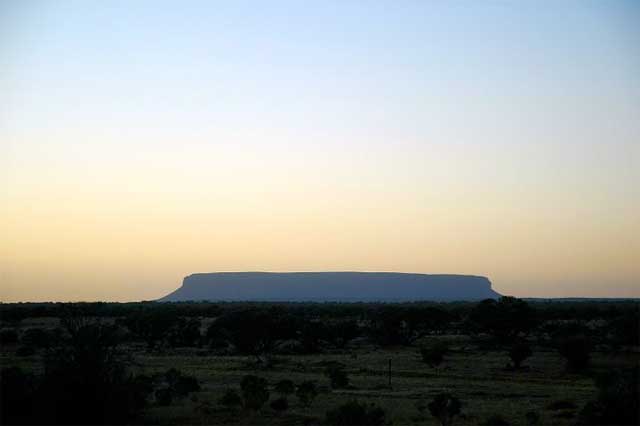Winter has arrived, and I am on my annual migration north. I am now over 2000 kms from Jamieson in the centre of Australia, driving along the Lasseter Highway, the bitumen conduit through the desert that ferries millions of tourists to Uluru. On the horizon to the south one can just make out the Musgrave Ranges, a spectacular mountain range rising 4000’ above the Great Victoria Desert. My mind wanders back to a time many years ago when I used to run expeditions deep into the heart of Pitjantjatjara Lands, to the mountains where explorer Ernest Giles wrote, “A white man could truly live and be happy”
To the south of this endless highway I travel is the singular massif of Attila, or Mt. Connor, a spectacular inselberg whose sheer buttressed walls rise spectacularly from the surrounding desert plains. The sun is coming up, spreading its first rays across a frozen frosty desert landscape, proof positive that overnight, the Ninya have been busy doing their dastardly work.
The highways department has recognized the importance of Mt Connor by installing a roadside viewing platform with toileting facilities at a high point. It is crowded daily with hundreds of international tourists who stop to relieve themselves, take in the view, then hop back in the rental and push on towards Yulara. I doubt that any of them are really aware of the significance the great mesa has, and the vital role it plays in the process of winter. And I am sure none of them are aware now close they would be to having their nuts frozen off save for the sanctuary of their heated motor vehicles nearby.
The Pitjantjatjara, or Anangu associate the mountain with a group of the most fearsome mythical beings in the dreaming – the Ninya or Ice Men. There is little to distinguish a Ninya from an everyday person, except that their bodies are a ghostly white colour, and there are icicles hanging from their beards and eyebrows. Long ago, back in the time of the dreaming or Tjukurpa the Ninya camped at Mt. Connnor, but in modern times they have moved, and now live beneath two salt lakes just north of the road we are on, in icy dark subterranean caverns. On dark winters nights they surface from the depths and make long expeditions across the desert, freezing the waterholes and laying frost across the land. A chill wind follows them. The ice falls from their bodies creating frosts, and on the higher peaks very rarely even snow.
In the cold of the dawn, the Anangu would sing the Ninya back to their dark caverns to bring on the warmth of the day. But in summer, when the outback is in the grip of oppressive heat waves, the women and children would assemble at Anneri soak near Mt Connor to coax the Ninya out of the ground, thereby reducing the temperature.
The outback is certainly a land of extremes. I have worked in the sandhills of the Simpson Desert when the thermometer has gone to 53° (127°F), where the baking dry air is so hot you must breathe in air slowly lest your nostrils burn. And once when camped near an abandoned native well in the central Simpson Desert whilst preparing breakfast I noticed my feet were acheing. When I checked the thermometer I noticed they were not acheing, they were FREEZING, the temperature was -8°C (17° F).
The road goes on. I struggle to overtake an endless stream a caravans and RVs all heading for Uluru, like giant snails dragging their carapaces behind them. I am comforted by the thought that soon I will be leaving this reality, leaving the bitumen and heading west beyond Uluru, beyond the caravans and crowds, back into Aboriginal lands, to the peace of the Western Deserts where unencumbered, the Ninya will continue their work.

